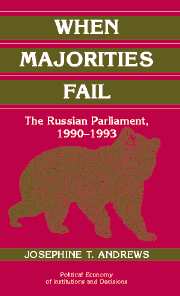Book contents
- Frontmatter
- Contents
- Acknowledgments
- 1 Introduction
- 2 Cycling in Action: Russia's Constitutional Crisis
- 3 Cycling and Its Consequences: A Theoretical Framework
- 4 Institutional Design and Implications for Majority Rule
- 5 Issue Dimensions and Partisan Alliances
- 6 The Structure of Preferences
- 7 Legislative Instability
- 8 The Dynamics of Agenda Control in the Russian Parliament
- 9 Implications of Disequilibrium in Transitional Legislatures
- References
- Index
8 - The Dynamics of Agenda Control in the Russian Parliament
Published online by Cambridge University Press: 02 September 2009
- Frontmatter
- Contents
- Acknowledgments
- 1 Introduction
- 2 Cycling in Action: Russia's Constitutional Crisis
- 3 Cycling and Its Consequences: A Theoretical Framework
- 4 Institutional Design and Implications for Majority Rule
- 5 Issue Dimensions and Partisan Alliances
- 6 The Structure of Preferences
- 7 Legislative Instability
- 8 The Dynamics of Agenda Control in the Russian Parliament
- 9 Implications of Disequilibrium in Transitional Legislatures
- References
- Index
Summary
In Chapters 5 and 6, I present empirical evidence to show that there were important differences in the structure of deputy preferences before and after the collapse of the Soviet Union. In Chapter 7, I present evidence to show how differences in the structure of deputy preferences led to differences in the nature of majority rule after the collapse of the Soviet Union. In the one-dimensional world that existed before the collapse, majority rule was well behaved; that is, outcomes did not cycle, and the chairman was constrained by the existence of a stable majority. In the multidimensional world that existed after the collapse, majority rule was not well-behaved; that is, either outcomes cycled (as they did in Session 4) or unstable majorities were susceptible to manipulation by the chairman.
In this chapter, I complete my empirical case by investigating how the nature of majority rule affected the behavior of the two chairmen. I hypothesize that before the collapse of the Soviet Union, when the issue space was one-dimensional, the presence of a stable majority limited what Yeltsin could achieve. After the collapse, when the issue space was multidimensional, the absence of a stable majority provided Khasbulatov with the opportunity to achieve his most desirable outcome.
- Type
- Chapter
- Information
- When Majorities FailThe Russian Parliament, 1990–1993, pp. 224 - 247Publisher: Cambridge University PressPrint publication year: 2002



